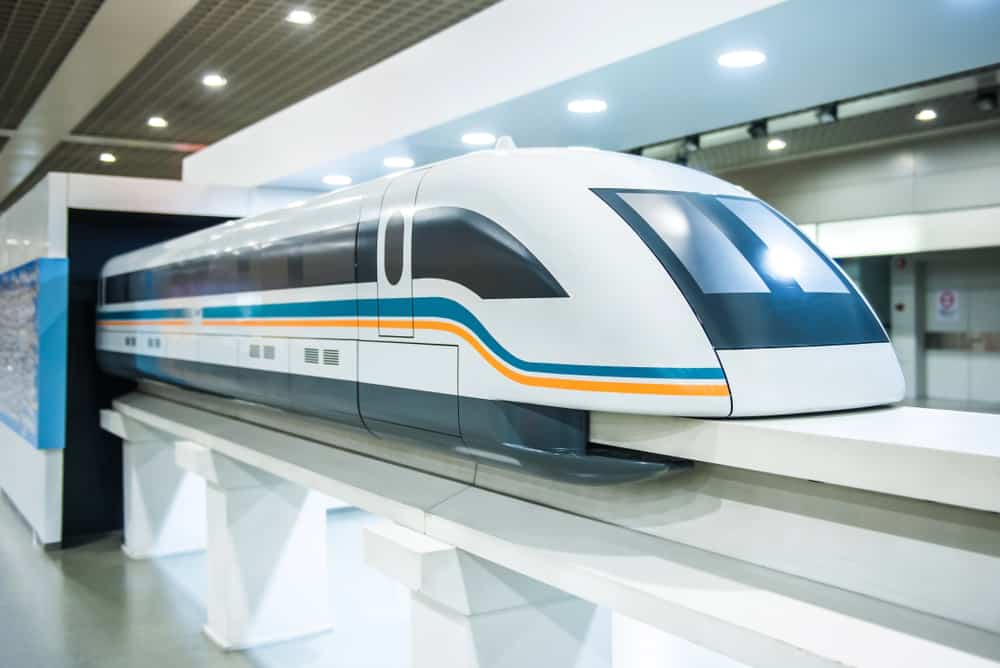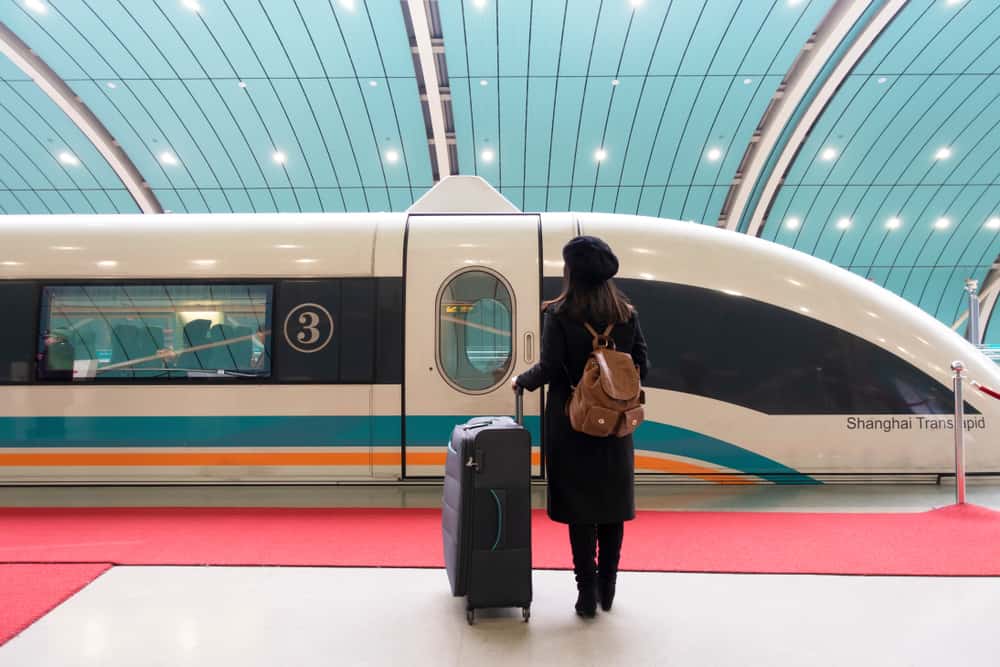In 1804, the first full-scale working steam locomotive train was built in the UK. The average speed of this train was less than 10 mph. It’s been more than two centuries since then. Now the world is finally seeing trains that can travel at a top speed of up to 373 mph. That’s more than 30 times their earliest speed. That’s close to half the speed at which sound travels (767.29 mph). The Maglev bullet train, currently considered the fastest train on earth, was unveiled in 2021. The train was built by the China Railway Rolling Stock Corporation, and it made its debut in Qingdao, China.
How Does The Maglev Train Work?

The Maglev bullet train operates through magnetic levitation, gliding it along the tracks at high-speed.
©MTS_Photo/Shutterstock.com
Not only is the Maglev bullet train the fastest train on earth right now, but it is also the fastest land vehicle. This high-speed train is truly an engineering marvel. That’s not just because of how fast it can go. The train is also quite stable, for such a high speed, all thanks to the technology behind its operation.
The “Maglev” bullet train uses a technology known as “magnetic levitation.” (the train’s name is an abbreviation of these two words). Electromagnetic force between the train and the tracks sends it gliding on the tracks at such a high speed. This is also why it appears like the train is “floating” on the tracks. The electromagnetic force keeps the vehicle’s body levitating at less than 2 inches from the specialized train tracks designed for it.
In essence, the train is riding on a cushion of air rather than being in contact with the train tracks like regular trains. Consequently, there is no friction between the Maglev train and the tracks, allowing it to travel faster than conventional trains. Although this technology has been around for a few decades now, this is the first time it is being applied on such a large scale.
Potential Impact of the Fastest Train on Earth On Travel

Maglev trains can help reduce the time and expense of travel, while decreasing the harmful emissions caused by other forms of travel.
©noina/Shutterstock.com
High-speed rail has been a major priority in China. It isn’t surprising that the government of the most populous nation in the world wants to connect its large cities with high-speed trains that can help reduce the time and expenses of travel.
It’s the same in many countries all over the world as well. As the world comes to terms with the realities of climate change and the impact of the current transportation systems, traveling by air is looking increasingly less attractive. This is inspiring many countries to look more closely at less harmful alternatives.
So far, the best solution seems to be high-speed trains. Not only is it more cost-effective compared to air travel for journeys of up to 700 miles, but there is also less emissions. A high-speed train like the Maglev bullet train traveling at an average speed of 295 mph is a compelling way to travel between cities. Additionally, rail’s ability to transport a large number of people quickly at the same time makes it a more efficient choice compared to cars, buses, or even unproven low-capacity options like the Hyperloop, the concept of ultra-high-speed electric pods.
Chinese Ultra-High-Speed Trains
China’s Railway Corporation believes that the fastest train on earth will considerably reduce passenger travel time. Moving at top speed, the fastest train on earth can complete the trip between Beijing and Shanghai (754-mile) in just two-and-a-half hours. It will take over 3 hours to complete the same trip by plane and more than 5 hours with current high-speed trains. What’s more? It’s a 12 hours trip by road. This makes the bullet train a particularly attractive option for travelers.
The average speed of high-speed trains that are currently in operation in China is about 350 kph. Trains travel significantly faster, at 800-900 kph. The bullet train and other magnetic levitation trains will find a critical middle ground between these travel options. The bullet train will be able to pull between 2-10 passenger cars. The vehicle, unveiled in 2021, is the finished version of a prototype unveiled back in 2019.
In addition to being significantly faster, the train also emits low levels of noise. This is another advantage it has over existing systems. Additionally, the train requires less maintenance compared to high-speed trains already in operation. It also features a “whirlpool” brake system which is considerably more efficient than the braking systems of previous high-speed trains. The new bullet train will only need 10 km (6.2 miles) to pull up. In comparison, the current Shanghai Maglev train takes 16 km (10 miles).
Fastest Train on Earth vs Future Transport Options
Existing transportation systems are not the only ones the Maglev bullet is giving a run for their money. At such a high speed, systems that are still in development, such as the Hyperloop projects, will have to do more to convince people of their viability. This is particularly important since they cost more to build because they’re such complex projects.
Hyperloops use a similar technology to the ultra-high-speed Maglev systems. But they’re constructed inside air-sealed tubes with vacuum pumps to keep the air pressure low. In theory, this allows the train to travel at high speed. Future hyperloop trains might have to top the current high speed of the Maglev trains or prove they’re better in some other ways if they are to be taken seriously.
Challenges And The Future

Maglev train arriving Shanghai station, it makes the 19 mile trip from the Shanghai Airport to Longyang Road station in 7.5 minutes.
©Yaorusheng/Shutterstock.com
Of course, being the fastest train on earth comes with some challenges. Currently, there are limited Maglev track networks to support their adoption. China has just one Maglev line in use at the moment. It connects Shanghai’s Pudong Airport with the Longyang Road station. The train is able to make the 19-mile journey in just seven and a half minutes.
There are reports that several new Maglev rail networks are in construction already. Despite this, there’s still a considerable wait ahead before they’re ready for full passenger service. Then there is the question of the commercial viability of such an ambitious project. According to the Guardian, the current high-speed Maglev trains that run between Shanghai’s CBD and the international airport cost about US $1.14 billion to build even though it is just a 19 mile stretch. There are doubts about the financial viability of such a project. That’s considering how much it’ll cost to build and keep it running once it opens.
The challenges notwithstanding, the Maglev Bullet is currently the fastest passenger line. But in this current golden age of ultra-high-speed trains, experts say it is only a matter of time before that record is broken. Already, the Central Japan Railway Company has started testing a Maglev that might be able to reach a top speed of up to 375 mph. However, the project is still a few years before it makes its full commercial debut, and China has enough time to further upgrade the bullet trains to even higher speeds.
Up Next
What Is The Deadliest Train In America?– Discover the America train line that has claimed more lives than it should.
The 10 Deadliest Train Crashes In The World– Train accidents don’t happen often. However, there have been a few deadly ones over the years.
The photo featured at the top of this post is © cyo bo/Shutterstock.com
Thank you for reading! Have some feedback for us? Contact the AZ Animals editorial team.







